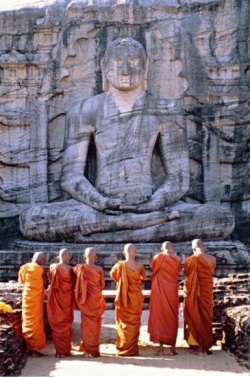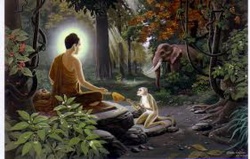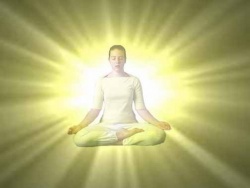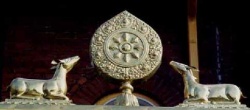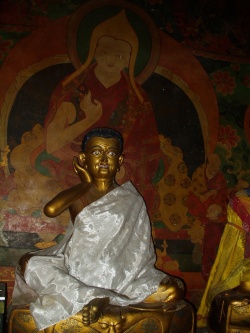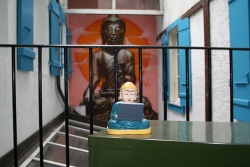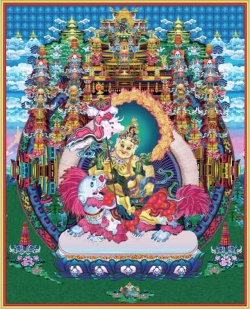Notes on the Chöd
Written by Yeshi S. Namkhai with the deepest respect and gratitude to
Chögyal Namkhai Norbu, wishing these notes to be useful for
Dzogchen Community’s practitioners.
This brief notes are connected with the knowledge of Chöd that you can find in the book “Chöd” based on teaching of ChNN from 1976 to 1991. Our condition is presented by four demons that hinder our realization, is very useful to understand from our own experience and not go after idea of “mysterious” practice connected with cementers and fear of the death. Self and Demons What is the “only” thing to be cutoff at the root? It is the ego.
Maching Labdrön focused on this point in the Chöd by making gift of her own body to others, but as a direct means for overcoming attachment to the self. In reality, as human beings, the basic principle underlying the practice of offering the body is connected with knowledge of what we call “demons”, anything that hinders our realization. Not holding on to our attachments and fears happen when we understand what “demons” really are. In Chöd practice they are some kind of being, the class of demons exist among beings but they are not real demons.
The real demon is principally nyemjed, which means the one who dominates. Whether we consider to be important what we call “I”, and then we develop this concept to include the idea of “mine”. From then on, the ego governs and controls everything. Machig Labdrön called this the principal “demon”, and other three type of demons arising from this one more connected with physical condition. The word used in Tibetan for demon is düd, but it’s real meaning is “impediment” or “hindrance”.
Thogche - block
We can consider the first demon connected with our senses, this also means that is material aspect and most of all limited. The aspect is the contact with object, the eye see form, the ears hear sound, the nose smells odors and so on for all the five senses and their objects. Then there’s the mind which reasons and think about all dharmas, meaning “all existence” (whatever is object of the mind). In the Dzogchen teachings there are what are known as the six self-liberations, tsodrug rangdrol. This means six liberations of the six aggregates or senses. When we are distracted, what happens? How do the senses function?
If, for example, our sense of sight has contact with an object, our vision does not remain in the principle of clarity. Instead, at that moment, our clarity stops and become blocked, because the sense contact is immediately followed by a judgment. If the object if beautiful, attachment arises: “How beautiful, I like it, I want it”. For example if a child see a puppy. The first moment he see it, he does not have any plans, but straight away he thinks: “How nice!” and begins to follow it and then to cry because he wants to touch it.
He is not just pretending, he is really suffering. The pleasant thing he has seen has already created a problem. If we don’t like something we reject immediately and define it saying “I don’t like it”, the base of anger. In general, there is always the principle of attachment/accepting or of anger/rejecting at work. Being conditioned with these emotions is how we create Karma, action and consequence. If we didn’t block the free flow of our senses and our energy by fixing a judgment to each experience, but liberated them as if we were in the state of contemplation, then we would be in the condition of Samantabhadra. However, when we are caught in distraction we create problems and that becomes a demon.
Thogmed - does not block
We can consider the second demon connected with the mind, this also means that is immaterial aspect and most of unlimited; therefore is called “not-blocking”. What is it that is not blocked but which causes problems? The mind cannot be blocked or limited by material things. For instance we cannot see what is in the other side of a mountain nor we can see or hear something which is very far away. This is because the capacity or function of our senses is blocked or limited.
With our minds, however, we can think about what is in the other side of the mountain and things which are very far from away. Nor is the mind limited by time, we can think about past and future and create so many problems. By thinking too much this hinders our realization. That is why we observe the mind when we do practice. Think how many good, bad and neutral thoughts arise each day and how many produce consequences because they create action. Often, is simply our belief which creates events or brings them about and the mind is capable of creating both positive and negative things. Many people create things in this way because they give too much importance to events. It is a very powerful demon.
Gagdröd - complacency
We can consider the third demon connected with the pleasure of pride, usually people live very superficially within society. If a practitioner gets a little but important or famous, or has a good position, everyone thinks that he is benefiting others and developing the teachings. They don’t understand that this is in fact another demon. In the practice of Chöd is considered very important to overcome this aspect. That is why masters and true practitioners do not like too much fuss and presentation. The Tibetans say “Even if he hits his head on a stone, he will not die”; it is true that there are times like this in our life, when all is good and positive energy, when even outer forces are favourable. When things are going well for us it is easy to think that we are rather special or important and we become arrogant. This is a great impediment, is one of the worst demons.
Nyemjed - ego
We can consider the fourth demon connected with who dominate our life, the aspect of giving importance to our self. It creates the “I” and “others”, with this distinction arise the attachment to my own position which sets me up against others. The ego needs to be eliminated from the position of importance. Chöd in Tibetan is a verb which means “to cut”, cutting off ego one finds himself in a condition beyond ego. The great master Pha Tampa used to say to his desciples: “A practitioner is not conditioned by vision but by attachment”. We always think we have to renounce things wich have negative effect (for ex. our body is the main source), but really it is the principal of attachment that we have to renounce, not materials things. Therefore knowing that the physical body is the main cause of attachment and that attachment arises in our minds, we train ourselves mentally to give away our body by practicing Chöd.
The main practice
The short points state what is the principle applied in the text of the practice of Chöd, to help to remind and apply more fruitfully.
Phat
PHAT is the essence of the Chöd, the condition of ego can be liberated very briefly by just using this sound. It is a very important means fro blocking the function of the mind: thoughts, judgments and fears. When you sound this word you should be present and you should notice the difference between the mind and the nature of the mind. The sound PHAT is used because pha is a strong, aspired sound; it is also a cutting sound and it is pronounced with a sharp , strong accent.
The offering and the guests
With the sound PHAT you can invite one by one the groups of guests, all possible guest can be invited. Also the principle is to invite most of all who you can’t bear, who bother you the most. In this way this unpleasant guest will be the first you offer your body, then second who disturb or interrupt you more. However the principle is not to dislike these beings but to understand our limits, for example consider our parents; in Mahayana sutras parents are presented as the symbol of the sense of compassion one should have for all beings. In general when performing ritual offering there are four main categories of guests, in the Chöd practice we sound PHAT for each:
Ratna könchog
The precious one, realized beings like Buddhas, Bodhisattvas and Arhats. We offer to accumulate merits and give meaning to our existence. In this way we overcome attachment to our physical body. In the practice of Chöd, we manifest as Dorje Phagmo or Sinhamukha and cut the head off our corpse and use it as kapala to cook our body in, so that it becomes a kind of meat soup. The offerings can be transformed because normally we offer: rupa, shapta, ghande, rasa, sparche. With the word jyan bel gyur offerings are purified, multiplied and transformed to whatever is needed. Once purified our body manifest all beautiful things, the object of enjoyment of five senses. Through the power of the mantra OM AH HUM the offerings are multiplied and authenticated with the sound PHAT.
Gönpos
All wrathful manifestations like Mahakala, the eight classes, the enlightened beings who have taken the form of Guardians.
Gegrig lenchag
The beings to whom we are linked through our karmic debts, for example our parents or our neighbors. Buddha said “Karma follows a person like his shadow; when there is a secondary cause, like the sun, the shadow will manifest”.
Six lokas
Guest of compassions, usually is said there are three upper and three lower lokas. These correspond to our main passions: lust the cause of birth as deity, jealousy cause of birth as asura, pride cause of birth as human, ignorance cause of birth as animal, attachment cause of birth as preta, anger cause of birth in hell.
The practice
Request for empowerment
The first part is request of empowerment which comes from a terma of the master Jimed Lingpa, hidden by Yeshe Tsogyal. The main verses invite to the dance on our ego, just like dancing on our head by Three roots and all manifestations instead of asking to protect us. Therefore we ask to realize this practice. Visualization of the refuge tree This part also comes from terma Chöd of Jimed Lingpa, as usual there no specific refuge tree to visualize in order not to fall in limitation. Therefore we visualize infinite refuge tree.
Refuge
These verses are fundamental to the understanding of the meaning of Refuge according to the Dzogchen teachings.
Bhodhicitta
Jimed Lingpa said that if the intention is good (or bad) the path and the realization will be good (or bad). The offering of the Mandala We offer without any attachment the mandala of our whole existence to overcome our ego and attachment.
Guruyoga
These are words of Machig Labdrön given to her son as the summary of her teachings. In front of us, in the space, in a tighle of five colors we visualize white Machig Labdrön (union of all masters) dancing like Vajrayogini with damaru and bell. In the three places appear in colored tighle white OM, red AH and blue HUM. We receive empowerment and authenticate our condition with the three Vajras.
The gift of the body
The gift of the body is the essential point of the Chöd. We transfer our consciousness (sem) into space through the central channel, just like in phowa, sounding PHAT. We offer our body, what remains? Only our consciousness that we transferred already. The body we offer had been created by dualism, with this action we overcome our four demons.
The invocation
At the end, in the state of rigba, the offerings, the one offering, those to whom the offerings are made are like a dream; just like reflection in the mirror. One continue in the recognition of the real state, integrate, remain in the state of contemplation.
The gift of the Teaching With great compassion it is offered to others to awaken them and in this way one place a positive cause. These words of Buddha himself are offered to all of the guests who are present.
The dedication of merits
This invocation also belongs to the terma of Jimed Lingpa , is very widespread in all Tibetan schools and, even though it is brief, it expresses very elevated concepts and most of all how should be our behavior as Dzogchen practitioners.
The final invocation
Relatively speaking, when we have made this offering of the body, we have paid all our debts. In the absolute sense, as we have also made the gift of the teaching and through this we have placed a good cause for all beings who have had this contact, when we ourselves become enlightened, all of them will become our disciples. Until the time of our enlightenment arrives, may the knowledge of the true condition arise in the consciousness of all the spirits and deities and other beings, so that they will no longer follow illusions and ego, so that compassion may arise in them. Also I practitioner, until I realize enlightenment and my practice is accomplished, my I succeed in integrating good and bad in the dimension of the Dharmakaya, thus creating many good cause with all beings through our direct relationships, both good and bad so that these relationships become meaningful.
Conclusion
The demons therefore, are not beings with long horns and terrible gaping mouths, coming from somewhere outside of ourselves to eat us up! Rather we have to discover that they are born within ourselves: that everything arises from our own inner nature. When we succeed in understanding this, then there is a way to overcome everything in the relative condition.
